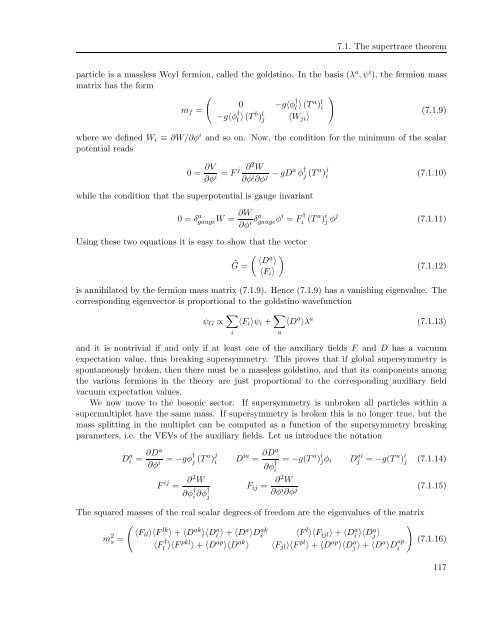Perturbative and non-perturbative infrared behavior of ...
Perturbative and non-perturbative infrared behavior of ...
Perturbative and non-perturbative infrared behavior of ...
You also want an ePaper? Increase the reach of your titles
YUMPU automatically turns print PDFs into web optimized ePapers that Google loves.
7.1. The supertrace theorem<br />
particle is a massless Weyl fermion, called the goldstino. In the basis (λ a ,ψ i ), the fermion mass<br />
matrix has the form<br />
mf =<br />
<br />
0 −g〈φ †<br />
l 〉(T a ) l i<br />
−g〈φ †<br />
l 〉(T b ) l j 〈Wji〉<br />
<br />
(7.1.9)<br />
where we defined Wi ≡ ∂W/∂φ i <strong>and</strong> so on. Now, the condition for the minimum <strong>of</strong> the scalar<br />
potential reads<br />
0 = ∂V<br />
∂φi = F j ∂2W ∂φi∂φj − gDa φ †<br />
j (T a ) j<br />
i<br />
while the condition that the superpotential is gauge invariant<br />
0 = δ a ∂W<br />
gaugeW =<br />
∂φi δa gaugeφi = F †<br />
i (T a ) i j φj<br />
Using these two equations it is easy to show that the vector<br />
<br />
˜G<br />
〈Da 〉<br />
=<br />
〈Fi〉<br />
(7.1.10)<br />
(7.1.11)<br />
(7.1.12)<br />
is annihilated by the fermion mass matrix (7.1.9). Hence (7.1.9) has a vanishing eigenvalue. The<br />
corresponding eigenvector is proportional to the goldstino wavefunction<br />
ψG ∝ <br />
〈Fi〉ψi + <br />
〈D a 〉λ a<br />
(7.1.13)<br />
i<br />
<strong>and</strong> it is <strong>non</strong>trivial if <strong>and</strong> only if at least one <strong>of</strong> the auxiliary fields F <strong>and</strong> D has a vacuum<br />
expectation value, thus breaking supersymmetry. This proves that if global supersymmetry is<br />
spontaneously broken, then there must be a massless goldstino, <strong>and</strong> that its components among<br />
the various fermions in the theory are just proportional to the corresponding auxiliary field<br />
vacuum expectation values.<br />
We now move to the bosonic sector. If supersymmetry is unbroken all particles within a<br />
supermultiplet have the same mass. If supersymmetry is broken this is no longer true, but the<br />
mass splitting in the multiplet can be computed as a function <strong>of</strong> the supersymmetry breaking<br />
parameters, i.e. the VEVs <strong>of</strong> the auxiliary fields. Let us introduce the notation<br />
D a i = ∂Da<br />
= −gφ†<br />
∂φi j (T a ) j<br />
i<br />
F ij = ∂2W ∂φ †<br />
i∂φ† j<br />
D ia = ∂Da<br />
∂φ †<br />
i<br />
a<br />
Fij = ∂2 W<br />
∂φ i ∂φ j<br />
= −g(T a ) i jφi<br />
D ai<br />
j = −g(T a ) i j (7.1.14)<br />
〈F †<br />
l 〉〈F pkl 〉 + 〈Dap 〉〈Dak 〉 〈Fjl〉〈F pl 〉 + 〈Dap 〉〈Da j 〉 + 〈Da 〉D ap<br />
i<br />
(7.1.15)<br />
The squared masses <strong>of</strong> the real scalar degrees <strong>of</strong> freedom are the eigenvalues <strong>of</strong> the matrix<br />
m 2 s =<br />
<br />
〈Fil〉〈F lk 〉 + 〈Dak 〉〈Da i 〉 + 〈Da 〉Dak i 〈F l 〉〈Fijl〉 + 〈Da i 〉〈Da j 〉<br />
<br />
(7.1.16)<br />
117
















